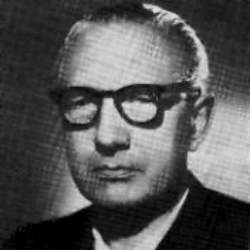
During the discussion of my article people argued that Dr. Fox was not exposed, only because he spoke of mathematics and the audience consisted of psychologists. However, I found out that the same thing had happen with mathematicians. This hoax took place at the prestigious École normale supérieure (ENS) in 1920’s Paris. The speaker on this occasion was Raoul Husson (pictured) and the most comprehensive readily available account is in Andre Weil’s autobiography1. He writes that while he studied at ENS:
'… the newly matriculated scientific class of 1923 received notification on the administration's official letterhead that a professor with a vaguely Scandinavian name would be giving a lecture on such-and-such a day, at such-and-such a time, and attendance was strongly recommended. The speaker was Raoul Husson, a more advanced student and a gentle prankster who later pursued a career as a statistician before finding his way to phonology and the scientific study of singing, to which he is said to have made some valuable contributions. In 1923, he appeared before the new 'conscripts' armed with a false beard and an indefinable accent, and presented a talk which, taking off from a modicum of classical function theory, rose by imperceptible degrees to the most extravagant heights, ending with a 'Bourbaki's theorem' which left the audience speechless with amazement. At least thus goes the legend, with the additional detail that one of the students who attended the lecture claimed to have understood everything from beginning to end.'
Another book2 gives one more detail: the Scandinavian name was Holmgren, but this is all one can learn from literature. So I decided to search for more facts. Unfortunately, two Husson obituaries3,4 do not mention any children, so he probably had none. So I started to search for children of lecture attendees. Prof. Jean Pradines, an ENS graduate himself, was good enough to send me the list of 21 people admitted to ENS in 1923.
I found Rene Coulomb, the son of one of lecture attendees, Jean Coulomb. He wrote to me that his father said to his elder brother Pierre Coulomb the following:
'Nobody had got anything out of this lecture save René de Possel who believed he had understood some ideas (but not the entire lecture contrary to what André Weil asserts).'
So now we know who “understood” the nonsensical lecture. Remarkably, this is not a marginal crank, but a respected mathematician, who has a Wikipedia article about him. De Possel was one of the members of the famous group of mathematicians, which published under collective pen name Bourbaki. This pen name was inspired by Husson’s lecture.
I am grateful to Todor Mishonov, for telling me about this remarkable lecture, to Philippe Elbaz-Vincent and Michel Zisman for bringing references 1 and 2 to my attention, and to Jean Pradines for supplying the list of the ENS 1923 'conscripts' and for sending a copy of reference 4.
References
- 1. André Weil, “The Apprenticeship of a Mathematician” (Springer, 1992).
- 2. Maurice Mashaal “Bourbaki: A Secret Society of Mathematicians” (American Mathematical Society, 2006)
- 3. G. Portmann, “Raoul-Nicolas Husson,” Rev Laryngol Otol Rhinol (Bord). Vol. 89 (1968) pp. 242-4.
- 4. A. Kastler, “Husson,” Annuaire des anciens élèves de l'ENS (1970) pp. 49-51. I am grateful to Jean Pradines for supplying this article.



